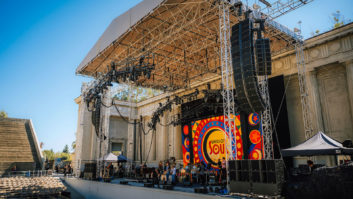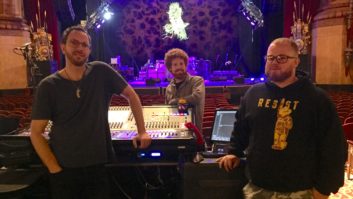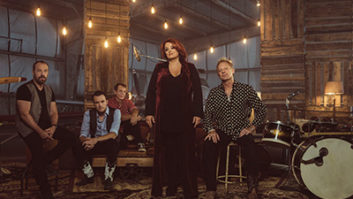Apparently, the two-time Grammy Award-nominated blues-rock artist Susan Tedeschi has never heard the term “keep it simple.” How do we know that? Consider these simple facts: She started recording her sophomore release Wait for Me in November 2001 when she was five months pregnant and was planning a December wedding. “It was pretty crazy,” she says with a laugh. “I’m always multitasking to the maximum.” No kidding.
Engineer Nate Dubé uses different words to describe the recording sessions’ pace. “It was like kamikaze recording,” he reports. “Sometimes we had to pin her down to get stuff done because she had the new baby. It was kind of like the military: Hurry up and wait. So, I’d get everything ready, and then wait. Then we’d throw down a lot of tracks, take after take, and did everything we possibly could. I sorted it out later.”
Actually, this is Tedeschi’s second attempt at recording this album. The first began three years ago in Louisiana. “I did record a whole record, but I didn’t release it,” Tedeschi explains. “The reason why was that I was doing a lot of Tom Hambridge songs and not my own. He wasn’t producing it, and he was trying to get producing credit for it. It was just a big mess. To make a long story short, I scrapped it and decided to hold out until I knew it was going to be right.”
So, the Wait for Me sessions started again in Jacksonville, Fla., with the late legendary producer Tom Dowd in charge. Production credit on this release is spread from Dowd to Tedeschi to her husband, guitar phenom Derek Trucks. “Tom did all the pre-production and did the basics with us,” Tedeschi says. “So, he was the producer on a big chunk of the tracks. Then my husband produced the two tracks with his band. Then we went back in the studio after I was pregnant and we did a bunch of those other tracks, and I produced it. So, I became the producer in the eyes of the record company. It’s listed as both, but I thought Tom did a significant part before he passed away. I was hoping that he would be around for the release and all that, but he didn’t make it. We are very sad about that.”
The sessions with Dowd were recorded at Made in the Shade Studios in Jacksonville by engineer Peter Thornton and then brought to Rear Window Studios in Brookline, Mass. (Tedeschi is Boston-based), via Pro Tools disks. Once at Rear Window, Dubé reports that most of the dates were recorded live to 2-inch tape on a Sony 24-track, except for Tedeschi’s vocals and guitar tracks, which went straight to Pro Tools. “That kind of disturbed me,” Tedeschi admits, “because I really wanted to do it on the live tracks. I usually think it sounds a bit warmer, sounds a little bit better. But Pro Tools is so good now that you can’t really tell too much. I was pretty impressed with that.”
Dubé’s studio plan, which was admittedly fly-by-the-seat-of-your-pants, boiled down to setting up the band, getting a good room sound and then hitting the Record button. Drums were miked simply, with an AKG D 112 stuffed in the kick drum, a Shure 57 on the snare and either Sennheiser 421s or Audio-Technica ATM25s on the toms. “I think room mics are imperative, especially stereo room mics,” Dubé says. He turned to Neumann KM84s (with a Neumann stereo baffle that simulates a stereo field) and then ran the signal through a Neve 9098. “I usually never compress my overheads, but the room just demands it,” he explains.
The biggest challenge Dubé faced while miking the sessions was isolation, especially when he went to mike the Hammond B3’s Leslie cabinet. After much experimentation, he found that the best Leslie mic was a Sennheiser 504: “504s on a B3? Who knew?” he asks with a laugh. “It worked because of the rejection, really. I figured they were small and they would reject a lot, and they did.” As for compression on the Leslie, Dubé reports he didn’t have to do anything because of the playing of Kofi Burbridge. “He had such good control over what he was doing, I didn’t have to do anything to his tracks,” he says. “He was like a volume master. I’m pretty sure I didn’t even use any external mic pre’s. I just used the Trident [console] mic pre’s.”
Although Tedeschi says she prefers old ribbon mics for vocals, Dubé turned to a Neumann 47 with a Telefunken V72 and a dbx 165A. “There are a bunch of compressors here, but that always works for me no matter what I try,” he says. “It always comes back to the 47 and any other pre doesn’t seem like it has the same midrange as the V72, and any other compressor makes it sound dull to me. There’s something about the 165A that just works; I love it. The high end is right there; you can’t really hear the compression that much, and believe me, the whole compression thing with the way that she sings — there’s definitely distortion on that record, but it’s not bad distortion. You don’t even have a choice; as soon as she starts barking, forget about it. She’s so dynamic, all I could do was basically set a level kind of close and hope for the best.”
One of Rear Window’s claims to fame is its extensive guitar collection, which thrilled Tedeschi — an accomplished blues guitar slinger — and Dubé to no end. “If there’s a guitar here that was made after 1962, I haven’t seen it,” the engineer says. “[Owner Milt Reder] has made it a point to try to accumulate a collection that is not like a bunch of museum pieces, but actually things you can use.” To prove the point, he reports that the guitar used on the song “Wait for Me” was an early ’50s Gibson L5. “It’s a big, honking, hollow, awesome thing that she was playing in the control room,” he says. As for the outboard chain used on Tedeschi’s guitar tracks, Dubé used either a Shure 57 or a Sennheiser 409, and if they were recording an overdub, he would hit an LA-3A for compression.
Technical aspects aside, one of the things that made these sessions a snap for all concerned was the musical talent involved. From Tedeschi’s touring band, to husband Derek Trucks’ outstanding band, to the guest musicians (including Rear Window’s Reder), each player poured themselves into the live performances. One case where the right musician made the song, according to Tedeschi, is “Wrapped in the Arms of Another”: “I had a few people come in and play piano on it, and I recorded it a few times,” she says. “Then I had Kofi play, and his was so beautiful. He’s just brilliant anyway. So, I figured that’s the one. We did it live. We both had to do it right, so we did it in about three takes. It’s live. It’s not exactly perfect, but it’s good to get more of that live feeling.”
Two other instances where they went for the take instead of perfection came on “Gonna Move” and “The Feeling Music Brings,” both recorded with Trucks’ band. “We ended up keeping the scratch vocal, just because the vibe was all live,” Tedeschi says. “I could have sung it better, but we just kept it because it was what happened live with that band. That energy is hard to re-create when you’re paying attention.”
Tedeschi admits that the newest member of the Tedeschi/Trucks family, Charlie, affected the way she sang on the album’s early sessions. “I couldn’t sing like I wanted to because I didn’t have the breath support with the baby,” she says. “So, we had to wait and finish up until after I had Charlie. I had him on March 6th [2002], and so once I started to get back into shape a little bit, I went back into the studio and finished it up in July.”
Coming off the Best New Artist Grammy nomination in 2000, Tedeschi feels like she made the album she wanted to make. “I tried to make it a little more dynamic, instead of all in-your-face kind of tunes, which is what the record company always loves,” she says. “I was like, ‘You know, this isn’t always about you. You’re not buying the record, you’re trying to sell them and make money on it. So, let me do my job and do what I think sounds good and then people will buy it.’ That was what I was kind of hoping for: Just do a good, solid record with good songs and good musicians. And that’s pretty much how I think it came together.”





